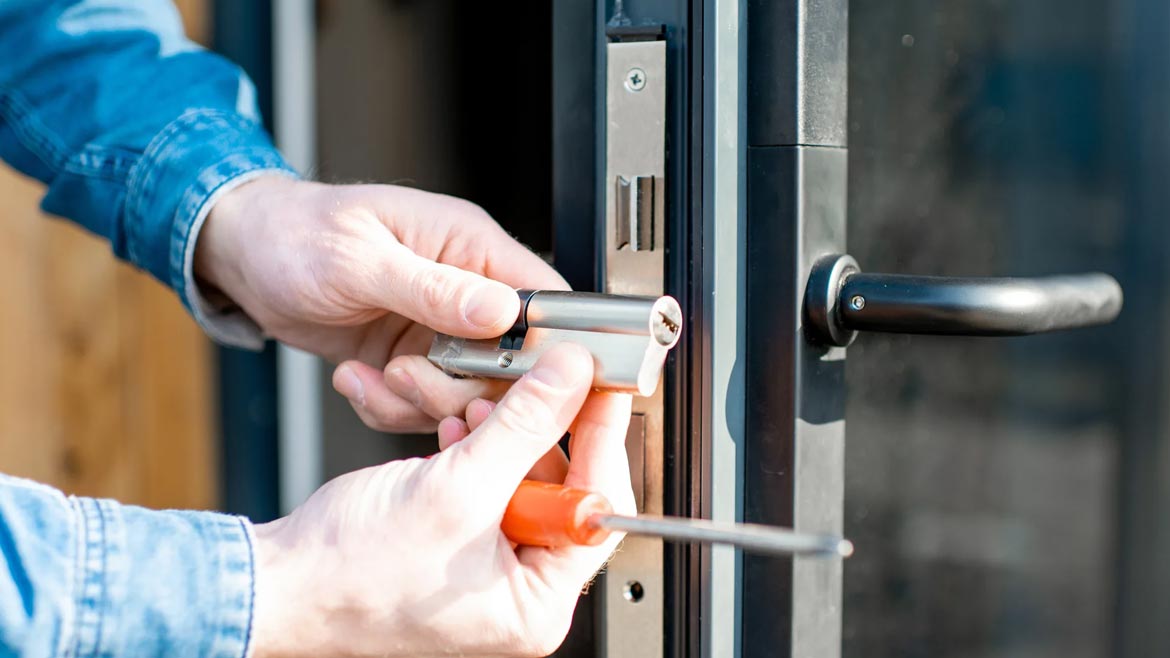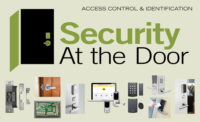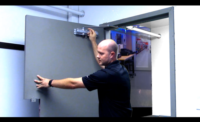Security locks and door hardware is an aspect of access control that may not make headlines as often as the cloud-based and mobile-first systems side of the niche; but it is an aspect that is equally important. It is an exceptionally technical part of the equation that involves complex part numbers, code compliance and continual training.
“Keep in mind that door hardware is the foundation of access control,” says Lester LaPierre, director of business development, electronic access control, ASSA ABLOY Opening Solutions Americas, New Haven, Conn. “With all the increasing demand and wider range of access control products and solutions, doors still must operate correctly, mechanically. You can put all kinds of electronics alongside door hardware, but if the doors and components aren’t properly installed and aligned, having a PIN code, card, or mobile credential becomes meaningless if a door doesn’t close or latch properly. You need good hardware, installation skills, and ongoing training to make that happen.”
Training & Education
To ensure successful installation, the proper training and education is necessary. Many security professionals point to a general lack of training and education as an industry-wide issue. Specific to locks and door hardware, experts stress the importance of establishing relationships with manufacturer representatives, hardware consultants, and locksmiths and locksmith associations as a solution for dealers and integrators in the locks and hardware space.
“Partner with an architectural hardware consultant (AHC) or electrified hardware consultant (EHC) to provide guidance on code-compliant applications and electrified locking system design,” says Mark Lineberger, electronics sales engineer, Allegion, Carmel, Ind. “You can find these certified consultants through the Door and Hardware Institute’s website (www.DHI.org). EHCs have the added ability to work alongside an integrator due to their understanding of physical access control systems. If you want to become more self-sufficient, DHI and various manufacturers offer plenty of educational resources.”

There are many different types of door hardware, with millions of permutations and combinations. Here are the most popular types of locks, as explained by Andrew Adams, assistant vice president of product marketing, door hardware, dormakaba, Indianapolis:
- Mechanical locks: Used in applications where occupancy of the room is less than 50 people. They can go on many different applications within a building, from a closet where you don’t need enhanced security, to a classroom where you want a greater sense of security.
- Cylindrical: These are surface-mounted locks that contain, typically, two through-bolt studs that enhance the security and durability of the lock.
- Mortise: These are mortised into the door for enhanced security. While the installation is a bit more involved with mortise locks, these locks are the most versatile due to manufacturers offering the ability to purchase cases and trims separately, which makes inventory of these products substantially simplistic.
- Tubular Locks: These are similar to cylindrical locks in that they are surface mounted, but typically do not come with through-bolt studs.
- Deadbolts: These are locks that don’t have a handle, but rather, are surface-mounted locks that contain a bolt that extends or retracts for additional safety. These bolts typically are an inch or more, which provides enhanced security of an application.
- Interconnected Locks: These locks combine a tubular lock and a deadbolt into a single product, which allows for simultaneous retraction of both the deadbolt, and the tubular lock latch. Some states require these locks to be used for fire code compliance.
Most manufacturers offer online as well as in-person training on their specific products. “Going a step further, tap into a manufacturer’s local sales team,” LaPierre says. “One of the most valuable ways to get up to speed on doors, locks, closers, hinges and everything else door and access control-related is through training that manufacturers like us provide. We have extensive eLearning, online video, and in-person/instructor-led courses available that cover everything from product overviews and hands-on installation training to codes and standards and much more in between.”
Some security integrators, like Preferred Technologies, SDM’s 2023 Systems Integrator of the Year, recommend getting involved in locksmith organizations that offer educational courses on locks, hardware, and installation, among many other topics. “The next way is actually getting involved with some of the resources available outside of the industry, and that would be the locksmith associations that are out there — organizations like the Texas Locksmith Association (TLA) and the Associated Locksmiths of America (ALOHA) ,” says Mark Dawson, design estimator, Preferred Technologies, Houston. “Here in Texas, the TLA have their yearly conference, and they have meetings that happen throughout the year. They put together a list of classes for those. [But] not all of those classes are going to be germane to an integrator or an installer, so it wouldn’t make sense for you to send your guys to all of those.”
In a hiring landscape that presents many staffing challenges, including finding candidates with a transferable technical background, Preferred Technologies identifies locksmiths as a potential talent pool. “Find a local locksmith who is worth their salt, and either sub them out so that they can do that part of the job for you; or, if you create a good enough relationship with them, you can just go and ask them the questions and they can get you the answers that you need,” Dawson says. “And maybe, for a fee, they might even teach your guys how to do it themselves. So that might be an opportunity for some sort of cross training that happens. The way we solve this problem at our company is we hire locksmiths. So I’m an example; I come from the locksmithing world, previously.”
Keep in mind that door hardware is the foundation of access control. With all the increasing demand and wider range of access control products and solutions, doors still must operate correctly mechanically.
Part Numbers
Locks and door hardware generate part numbers based on every aspect of the product. A change in finish, handle, or color is a change in part number, and getting that number right is critical to a smooth installation and a satisfied customer.
“There’s a lot to get wrong with locks,” Dawson says. “The part numbers for door hardware are exceedingly complex, and they’re very customizable. From the start, know what product you need to order, get the right part number for it and order it. Once you’ve got the right product in your hand, putting it on the door is a much easier task. There’s nothing worse than trying to go and put a lock on a door, taking it out of the box, and realizing that it’s the wrong handle, it’s the wrong color, it’s the wrong voltage, or it’s the wrong size.”
Dawson says that difficulty in part number generation is a great time to turn to manufacturer representatives. “Anytime I, even as a locksmith who’s been in this industry for well over 15 years now, have a question about a new product, or I can’t quite figure out how to create that part number, I can lean on them,” he says “I can tell them I need it this big; I need this color; I need it with this cylinder; and I need this handle; can you build the part number for me? And I can rely on them to make sure that they get that stuff accurately, because that’s their job. Their job is to figure out those finer details and things, but the more you can get those details correct at the beginning of the process, the more smoothly the execution goes.”

Code Compliance
Locks and hardware are another subset of security that has to navigate codes, standards and regulation. Having an intimate understanding of those is integral. “Understanding codes and standards, the importance of taking them seriously, and keeping up with them tops our list,” LaPierre says. “It’s essential to prep a door properly, follow prescribed templates and instructions to the ‘T,’ use the hardware provided, and refrain from substituting components and cutting corners.”
Each individual piece of hardware has their own standards and specifications. “Doors and door hardware are highly specialized and require an intimate knowledge of local codes and fire door requirements,” says Tom Morrison, national sales director, Security Door Controls, Camarillo, Calif. “Hinges are determined by door size. Labeled fire doors have to be self-closing and latching. Hardware mounting heights need to be coordinated for uniformity. Lock functions are determined by building usage and application. Doors that are paths of egress may require exit device hardware depending on occupancy requirements. Fire labeled doors need to be supplied with UL-rated hardware to meet the code requirements.”
Morrison continues, “ There is a lot of work that goes into engineering an opening to meet the requirements. The best advice I could offer any integrator is to partner with either a contract hardware house or a very qualified locksmith. Not all locksmiths are equal. You want to make sure you are working with a locksmith who understands the local code and requirements of labeled and specialized openings. The locksmith also needs to understand the limitations of what modifications can be done in the field to a rated opening.”
If these specifications are not met, the end result could be a serious risk to life safety and security. Even if caught in time, it could still mean expensive and time consuming rework.
“Another common oversight is neglecting fire, life safety, and ADA compliance, which can lead to costly rework or safety hazards,” says Brian Thomas, chief sales officer, The Cook & Boardman Group, Winston-Salem, N.C. “Installers should be familiar with local codes and ensure hardware meets all standards for emergency exits and accessibility, while properly integrating mechanical and electronic components to ensure a smooth, compliant installation.”
The reality of the situation is that commercial openings have become intelligent and electrified, but that doesn’t mean that proper installation of security locks and door hardware has been left behind. There’s still a great demand for the expertise offered by experienced lock and door hardware installers and locksmiths.
“The days of an opening being strictly mechanical and standing alone is in the past,” Thomas says. “As technology evolves, the integration of mechanical and electronic components allows for more advanced, scalable, and user-friendly access control solutions. Successful installations go beyond just locking doors — they involve a holistic approach that considers compliance, user experience, and long-term maintenance. Staying current with technology and standards, while fostering collaboration with locksmiths, manufacturers, and integrators is key to delivering secure, adaptable systems.”







